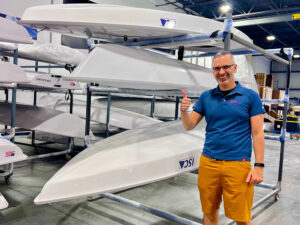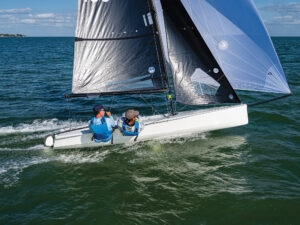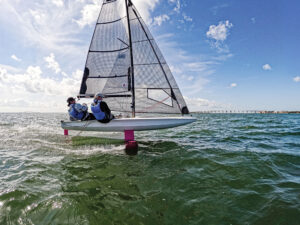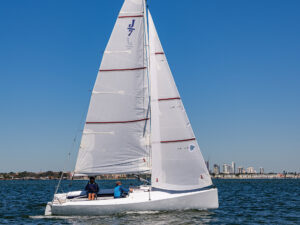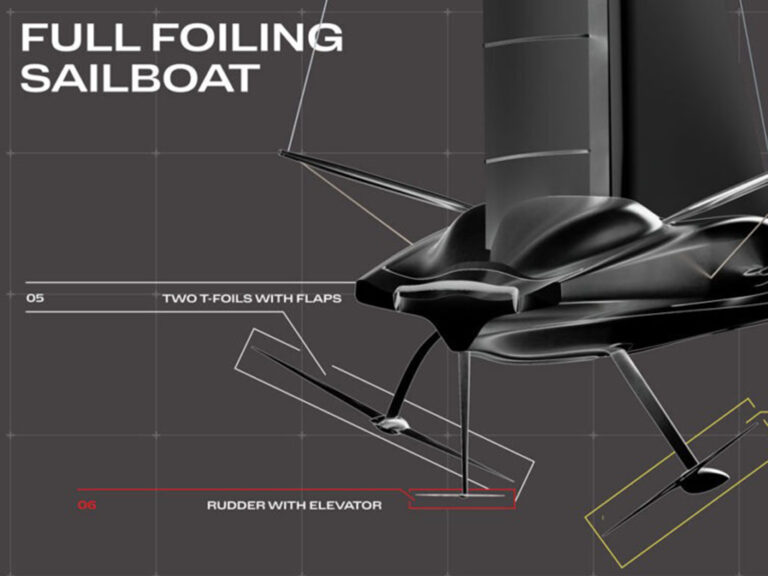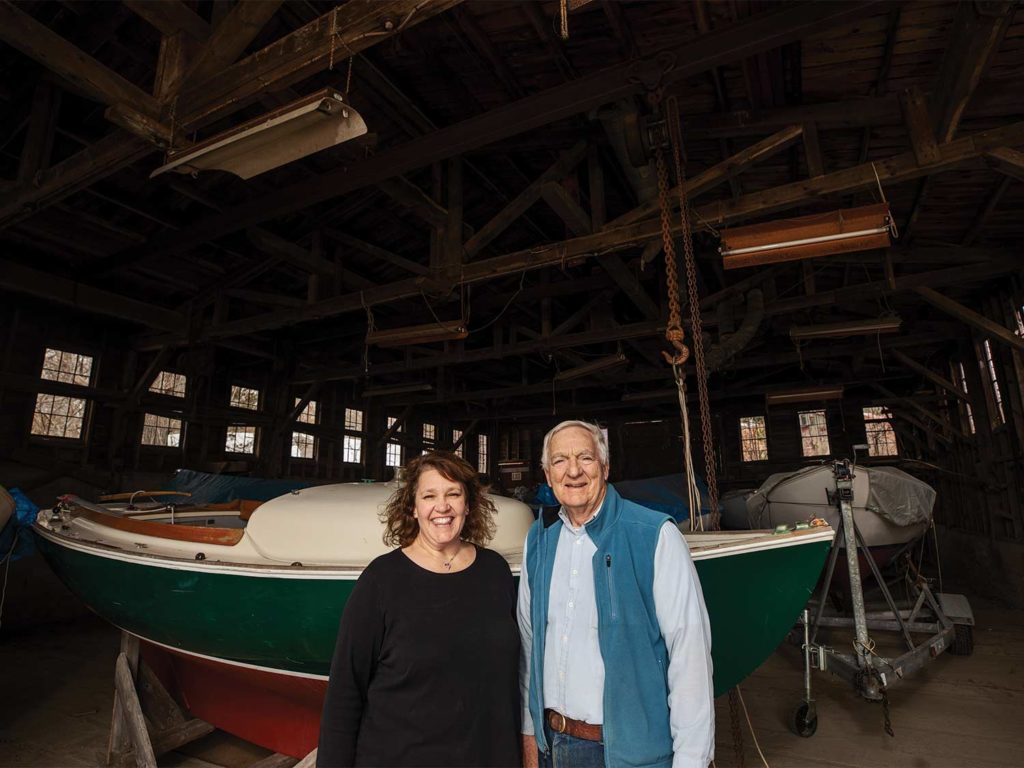
Wendy Goodwin had been so busy running Cape Cod Shipbuilding, the 122-year-old family business, she didn’t have time to have a family of her own. Then the pandemic hit, the opportunity arose, and she began the process of fostering to adopt an 8-year-old girl.
On a day in early spring, when the sun shines on the Cape and the winter is almost forgotten, Goodwin’s daughter is in her office attending math class remotely. Goodwin is in a spare room, once the domain of the parts manager. Long before that, this space was where her grandfather, Les Goodwin, slept with his ballerina bride, Audrey, in the early days after they purchased the boatyard.
The place today certainly looks its age. Past Cranberry Highway, on the south side of the two-lane Narrows Road, a sign welcomes visitors onto the waterfront property along the swift-running Wareham River, which feeds into Buzzards Bay. A dozen buildings of different sizes and shapes are strewn about the 9.5-acre grounds. Most wear their patina of age with pride. All serve their purpose. No one ever said that a working shipyard had to be fancy, but quite a few boats inside and under Cape Cod’s care certainly are.

The past here is omnipresent. Outdated molds gather moss and have become part of the landscape, proving the longevity of fiberglass. Old-growth wooden floors inside the buildings are worn smooth by generations of boatbuilders. Big machines, lathes, jigs and tools created by dearly departed artisans live on, ready to put in an honest day’s work on designs that may well be immortal.
A nautical archeologist would have a field day here; it seems that bits of the past are behind every open door or cracked windowpane. Beneath these buildings and buried deep in the soil, he or she could very well unearth artifacts from the late 1800s, the time when—according to local historians—brothers Myron and Charles Gurney were manufacturing wagons and carriages on the western bank of the river. The Gurney brothers later got into skiffs and dories, and then sailboats—namely the Cape Cod Knockabout, an 18-foot one-design by Charles Gurney, first built in 1925 and still raced in parts of New England.

Upon the passing of Charles Gurney, a fellow by the name of G.S. Williams took ownership in 1935, but according to company legend, Wendy Goodwin’s grandfather Les Goodwin, a dealer from New Jersey, bought the company after visiting to complain about the quality of the builds he was selling. He and Audrey relocated to Wareham and moved into the office to run the new company.
In 1940, so their story goes, Goodwin purchased the Sparkman & Stephens-designed Mercury and built more than 200 of them while also building military tugs and launches for the US Navy. Postwar production then returned to small craft and one-design sailboats. According to the company archives, the Goodwin family enjoyed a rush of fiberglass production: Herreshoff Bull’s Eyes (derived from the Herreshoff 12½) in 1949, followed by Ravens in 1951, the W. Starling Burgess-designed Atlantic in 1956, the Knockabout in 1959, and the Capt. Nathanael Herreshoff-designed Goldeneye in 1960. It was 1962 when now-Hall of Fame inductee Cornelius Shields turned to Goodwin to build his eponymous one-design, drawn by Sparkman & Stephens.
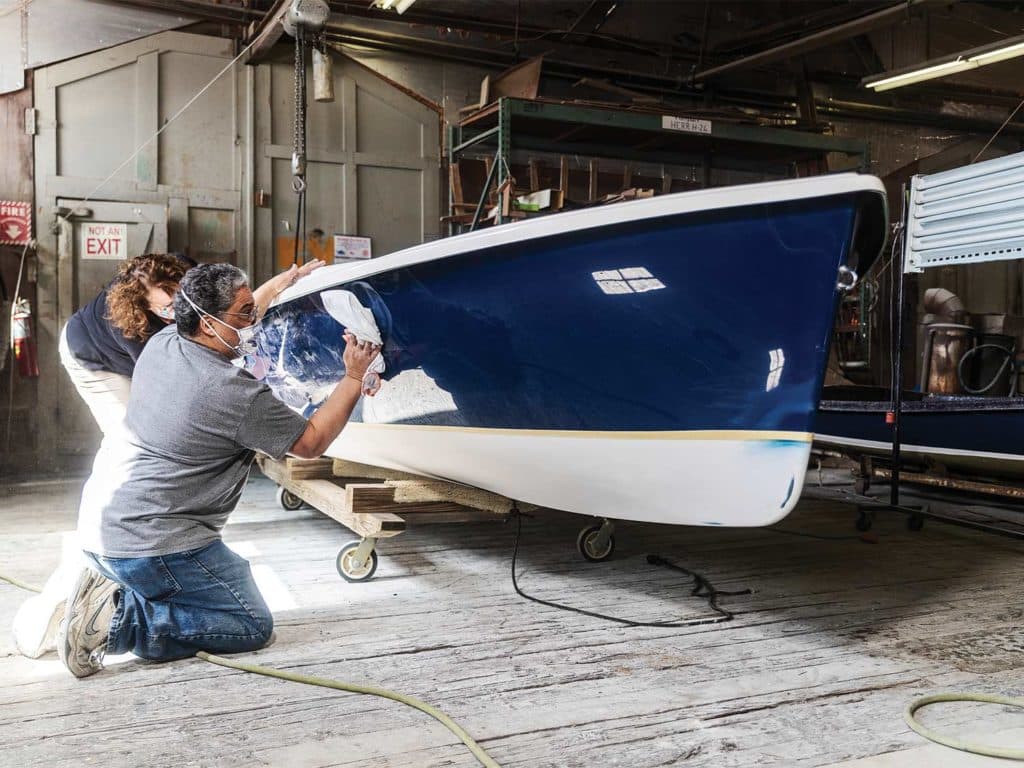
Goodwin’s son, Gordon L. Goodwin, began working full time for the family company in 1969 and led Cape Cod Shipbuilding through its next chapter as a full-service boatyard. As it should come as no surprise, in 1993, Wendy Goodwin joined and brought a generational trifecta to the yard. The following year, E.L. Goodwin passed away at the age of 95, right before the yard was contracted to build new boats for the Day Sailer one-design class, which continues to this day.
Family is the keel of Cape Cod Shipbuilding, and it has kept the business upright and on course for more than 100 years. Goodwin’s first memory of the shipyard is feeding ducks from the dock when she was 4 or 5 years old. When we meet in early April 2021, she was out of breath, having just launched a flotilla of docks, which marks the beginning of another busy season on Massachusetts’ south coast. It’s the ebb and flow of every New England boatyard: Good weather brings customers out of the woodwork, and on this day, Goodwin’s phone and email inbox are blowing up.

One of the many challenges of keeping this boatbuilding business afloat in the United States in general, and on Cape Cod in particular, is balancing repairs with new builds. When people are not commissioning new boats, Goodwin takes on more repairs. Managing customers’ expectations, she says, can be more challenging than managing the workflow. “The hard part is letting customers know that we have an abundance of new boat orders and we can’t get to a repair,” she says, “or vice versa.”
Some in the industry might call that a good problem to have. Diversification is a sound financial practice. It’s also a wise strategy for a boatbuilder.
“The fact that we don’t have all of our eggs in one basket is the reason why we are 122 years old,” Goodwin says. “We don’t do just one thing. Right now in my shop, we have three Day Sailerss, one Heritage, some Bull’s Eyes and Herreshoff 12½s. If I didn’t have the Herreshoff 12½s to varnish every year, we couldn’t keep the payroll going. There’s no one bread-and-butter boat.”
At times, being the president of the operation means difficult decisions must be made, such as retiring boats like the Cape Cod Knockabout, which are no longer financially viable. “Dad didn’t talk to me for a week after I decided that,” Goodwin says, “but it was the right decision for the company.”
Regarding Wendy’s work ethic, the tree isn’t far from the fruit. Gordon could be retired at his age, but instead, you’ll find him at the boatyard every day. “You’ve got to get out and get the men and get them going so they can build the boats so I can go home and put bread on the table,” he says.

Is building antique one-designs romantic? Wendy Goodwin laughs when I ask—it’s something she does quite frequently. “This is not a romantic job,” she says. “That’s how people sell books and stories—the romance of boatbuilding. In reality, boatbuilding is dirty and smelly. What I find fantastic are the relationships and connections I make with other people through boatbuilding.”
One of those people is Matt Holt, the new owner of an older boat. Holt lives in the British Virgin Islands, and his boat, Tern, is a Cape Cod Marlin, designed by Herreshoff and built at Cape Cod Shipbuilding in 1961.
Holt describes Tern as “your most comfortable pair of jeans,” and says before he took ownership, Tern was cared for by Englishman Dr. Robin Erskine Tattersall. Tattersall modeled for the famous photographer Richard Avedon, represented the BVI in the Soling class in two Olympic Games, and cared for the medical needs of his community.
For 40 years, Tattersall loved and sailed Tern. Two back-to-back Category 5 hurricanes, Irma and Maria, however, did a number on it. Tern’s dock was ripped out, it was struck by numerous charter yachts, and partially sunk deep in the mangroves. Its spars were broken, but the hull was intact.

Tattersall sold Tern to Holt for $10, with the understanding that he was its new steward. Holt reached out to Goodwin, and a trip to the records room in Building No. 33 revealed that Tern had indeed been built by her grandfather in 1961, and she was able to locate the paperwork, which documented all of its parts.
The historical records collection at Cape Cod Shipbuilding is vast, not so much because grandpa Les Goodwin was trained as an archivist, but because he didn’t throw away anything. The old invoices, Goodwin says, are invaluable when new owners of older boats discuss refits. “The fact that these boats are going on three, four generations, it’s pretty awesome.”
Goodwin and her team were able to re-create a spirit of a traditional rig for Tern featuring a single extrusion tapered mast, a new boom, standing rigging, running rigging, sails and covers, all shipped to the BVI. “The crate they built for me was two-by-fours covered in carpet. The rigging was laced into the crate using the sails as cushion,” Holt says. “The two-by-fours were covered in plywood. They hit a home run with the delivery, which was no small feat getting it down to this little island in the Caribbean.”
This dedication to craftsmanship brings all types of customers back to Cape Cod Shipbuilding. One fan is Olympian, sailmaker and world champion of many classes Steve Benjamin, who once fell in love with Atlantic No. 128, Cassidy. Benjamin was struck by the beauty and sailing capabilities of the W. Starling Burgess design. He also was impressed by the competition, the camaraderie, and the opportunity for mature sailors to remain competitive.
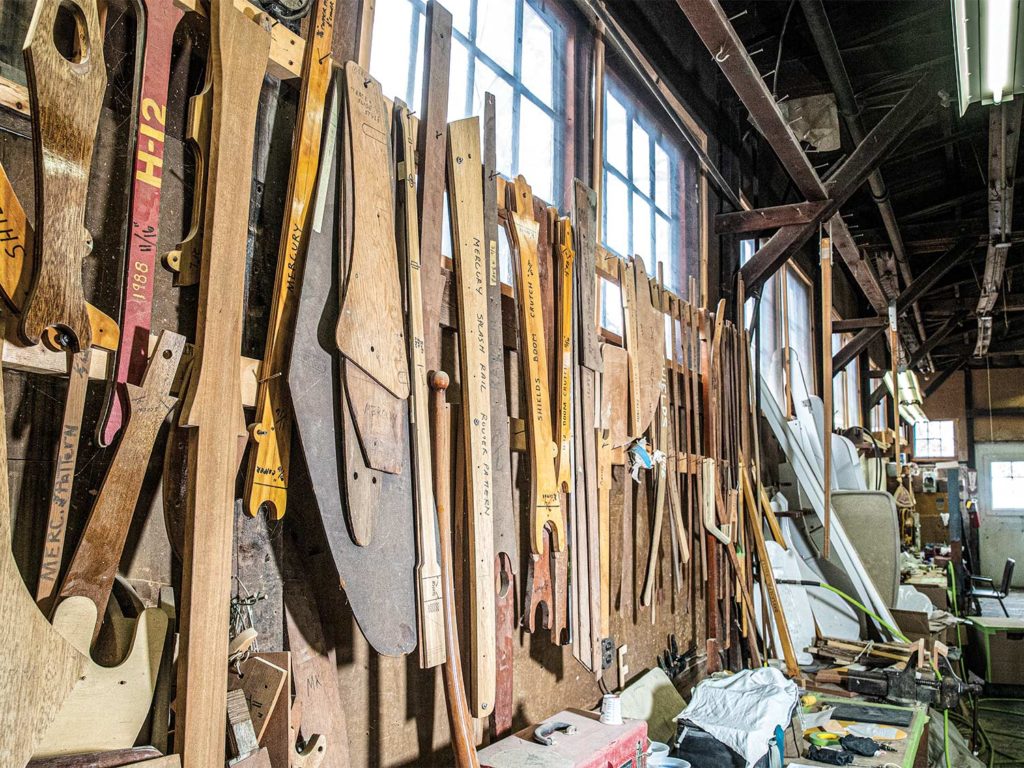
A skipper known to keep his race boats in Bristol condition, Benjamin has refit at least 10 boats over the years. Cassidy needed new deadwood on the keel, which was completely waterlogged, a topsides paint job in Awlgrip, and a bottom job coated with Baltoplate.
Past Olympians are not the only sailors who enjoy boats built by Cape Cod Shipbuilding. Geordie Shaver has sailed in five America’s Cups, and these days he gets his kicks racing in Newport, Rhode Island’s cutthroat Shields fleet. Shaver estimates that 90 percent of the Newport Shields fleet were built by Cape Cod Shipbuilding. And when there is a problem, people are happy to have an active builder nearby.
Like many boatbuilders, Cape Cod Shipbuilding would like to receive group orders for one-design fleets because building one boat at a time is less efficient. In fact, if a group order of six boats arrives for a retired design, Cape Cod Shipbuilding is happy to build the boats.
With the Shields class, Goodwin says, the goal is to always keep things one-design. “We’re walking a fine line keeping the class alive and making sure the competition is fair,” she says. “I don’t want the new boats to be slower or faster than the existing boats. We’re loyal to all of our fleets to make sure things don’t change.”

After listening to all of her customers, Goodwin noticed that many Herreshoff 12½ owners were tired of wrestling with outboards and outboard brackets. Looking to the future, Cape Cod Shipbuilding invested in crafting a redesigned Cape Cod Marlin Heritage. Designed by Herreshoff, the classic combines the best of the Fish and Marlin designs, and offers modern amenities such as inboard power, an iPod-ready sound system, and USB charger ports. A just-built flag-blue example sits on a railway cradle that leads to the water, freshly varnished brightwork shining like a gem.
No amount of cajoling will get Goodwin to name her favorite boat at Cape Cod Shipbuilding, but she will admit that the boat the family owns is a Shields. She was the Shields-class secretary for quite a few years and co-wrote a book about the class turning 50. “I adore the racing and the competition,” she says. “There’s nothing I like better than getting together in the cockpit and working together to make the boat move. It’s about the people in the cockpit and the smarts that’s shared between them.”
Goodwin’s love of sailing would strike a chord with her grandfather Les, who once wrote, “Sailing is a family sport that can be enjoyed by young and old together, so I hope my little girl may learn to sail, race and love small sailboats as real insurance against becoming a ‘sailboat widow.’”
In due time, Goodwin may well say the same thing to her daughter, who, should she keep up with her math homework, could be the next Goodwin to keep Cape Cod Shipbuilding sailing into the future. ν

